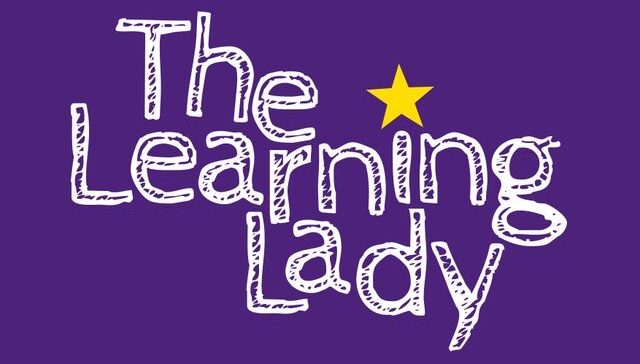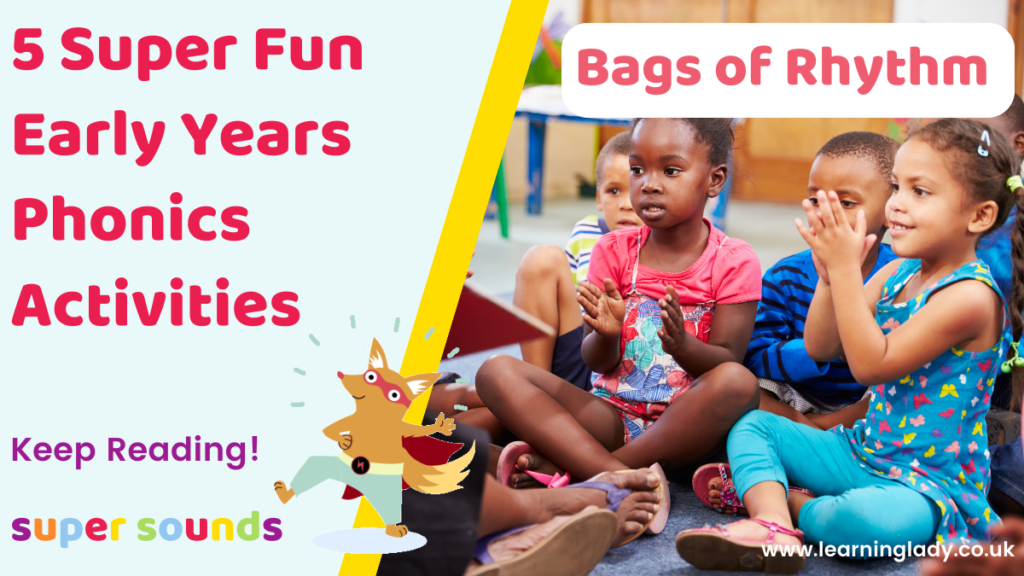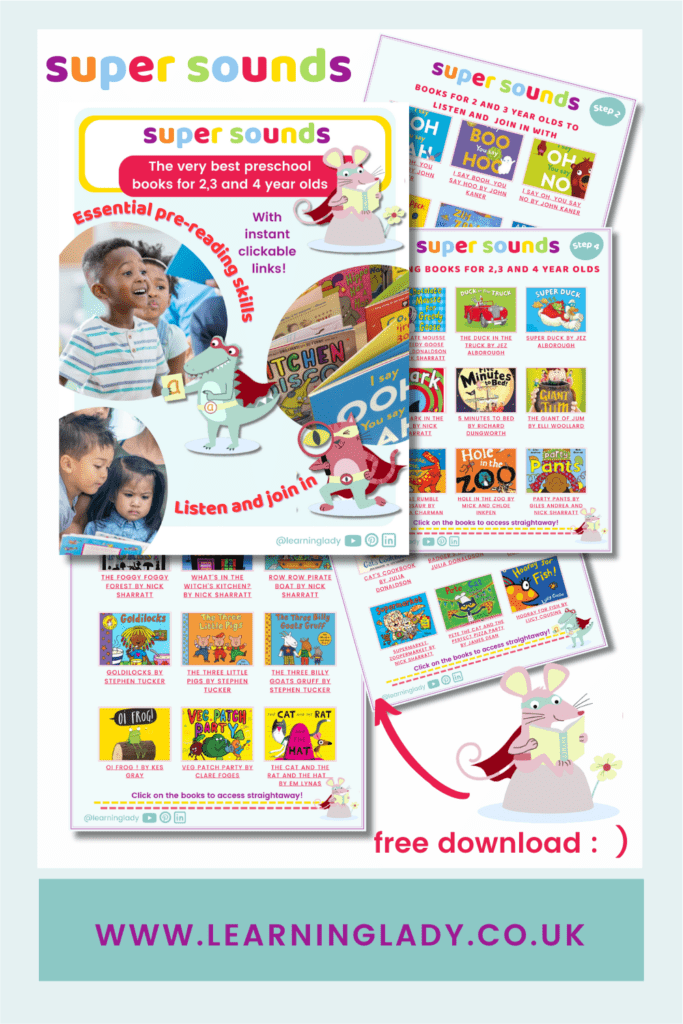I hadn’t always understood the significance of rhythm in early years phonics activities, but I learnt a lot from Patience. This super enthusiastic pre-schooler had a love of music, an amazing sense of rhythm, but little experience with books.
This is the story of how having fun with rhythm helped Patience to get ready for reading.
Why play rhythmic, early years phonics games?
Patience hadn’t encountered many books with rhythmic patterns. In our mission to introduce her to books, it was important to link these as much as possible with the rhythmic early years phonics games she loved.
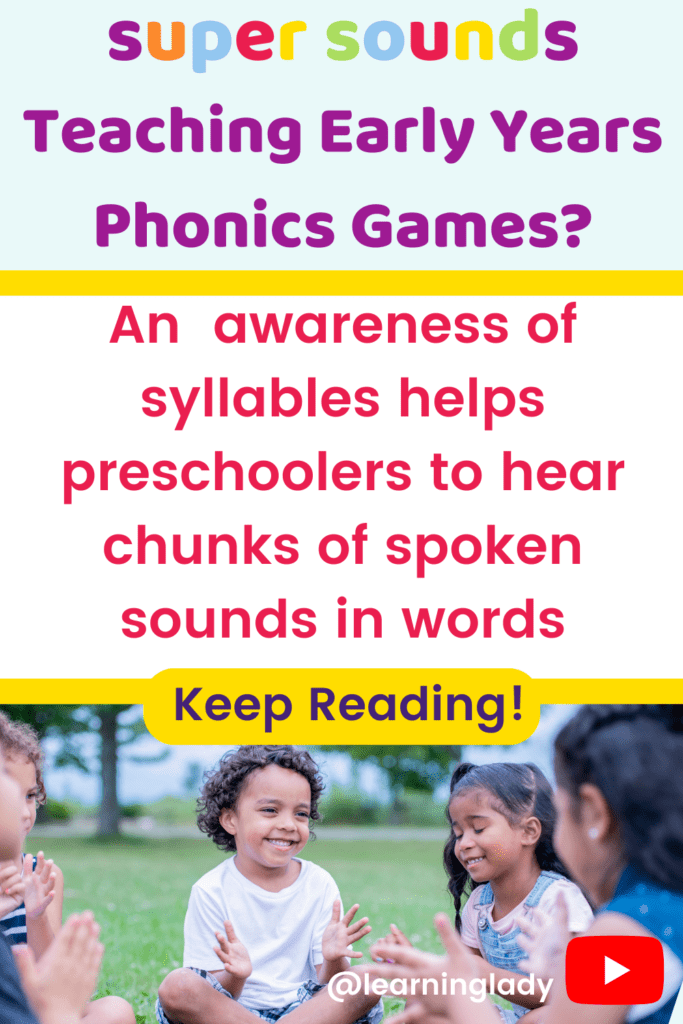
Developing an awareness of syllables
This wasn’t simply about getting Patience hooked on books (although that was important).
Developing an awareness of rhythm is an essential step required before introducing letters and sounds.
If 3-year-olds like Patience can’t hear large chunks of sound made by syllables, then hearing the single sounds required in phonics activities is much more challenging.
This is part of what is known as phonological awareness.
What makes a rhythmic activity?
Rhythmic stories, songs and games all include patterned and predictable language, created by syllables. Syllables are the number of ‘beats’ we hear in words.
These are created by the vowels.
Rhythmic activities help pre-schoolers to transition from knowing words as labels for objects, actions, and ideas, to understanding that words can be broken up into ‘chunks’ of sound.
Rhythmic and patterned books | The perfect starting point!
Books like We’re Going n a Bear Hunt or Brown Bear, Brown Bear What Do You See? are perfect examples rhythmic books.
The authors use the rhythm of syllables to create books which are super easy for preschoolers to remember.

Learn more about why rhythm matters preschool in this super speedy explainer video!
When to start introducing rhythm into nursery phonics activities
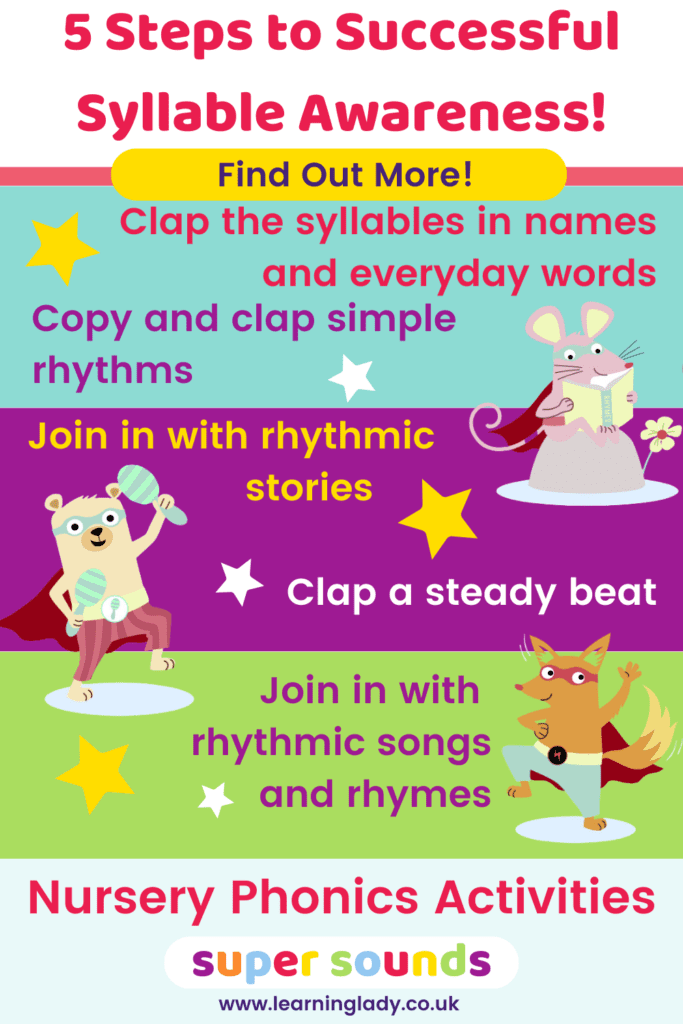
Preschoolers need lots of experience in moving rhythmically to music, and clapping a steady beat before they can affectively tune into the rhythmic patterns.
It’s much easier to hear the beats in music than it is in words!
Patience was ready for rhythm
We knew that Patience was ready to learn more about the rhythm of language because she could already clap a steady beat during our nursery phonics activities, and she LOVED to move rhythmically to music.
Patience and her friends loved to play games like Follow the leader, or sing songs like Feel The Beat where we purposefully practised moving to the ‘beat’ all together.
The best books for early years phonics
We started by evaluating our books to find the ones with predictable and patterned language and a recognisable rhythm. It was surprising to find that we had quite a few! Here are a some of our favourites:
- The Train Ride by June Crebbin
- We’re Going On A Bear Hunt by Michael Rosen and Helen Oxenbury
- Brown Bear, Brown Bear, What Do You See? by Bill Matin Jr and Eric Carle
- The Bus Is For Us by Michael Rosen
- The Kitchen Disco by Clare Foges
- The Veg Patch Party by Clare Foges
- Chocolate Mousse for Greedy Goose by Julia Donaldson and Nick Sharratt
- Pants by Giles Andrea and Nick Sharratt
FREE Download!
If , like us, you’re scratching your head, trying to think of a list of rhythmic books, perfect for early years phonics, then here’s just the thing!
The FREE Super Sounds Booklist has over 100 prephonic books to share with your 2,3 and 4 year olds, covering all of the prereading topics you need for perfectly prepared preschoolers.
Full of instantly clickable links, it’s an immediate timesaver for professionals and parents, and because it’s digital you can share this booklist far and wide. And it’s FREE!
Early phonics activities can happen anywhere!
Getting to grips with hearing the rhythm and syllables in words takes practise in lots of different ways.
We had learnt through experience that early phonics activities can’t only be delivered for 20 minutes sitting at carpet time.
Children like Patience needed us to bring the books to life through a ‘little and often’ approach.
Some rhythmic activities we tried!
Using the rhythmic books we’d selected, we thought about super simple ways of using resources that the children already enjoyed. We decided to take the books and rhythmic games to the children, rather than making the children come to the books.
We added the Kitchen Disco by Clare Foges , and matching fruit characters, into the role play house and had our own kitchen disco in there!
We put lots of different pants in the water tray for washing, and added a washing line. We put Pants by Nick Sharratt near the washing line so we could read that alongside the washing.

5 more super fun early years phonics activities for teaching rhythm, using books
Fun Early Years Phonics Activities 1
Copy My Claps
As part of our language building activities we read Handa’s Surprise. For some children, just naming the exotic fruits and animals was enough. But for children like Patience, we also introduced a super simple clapping game using the fruits in the story as our inspiration.
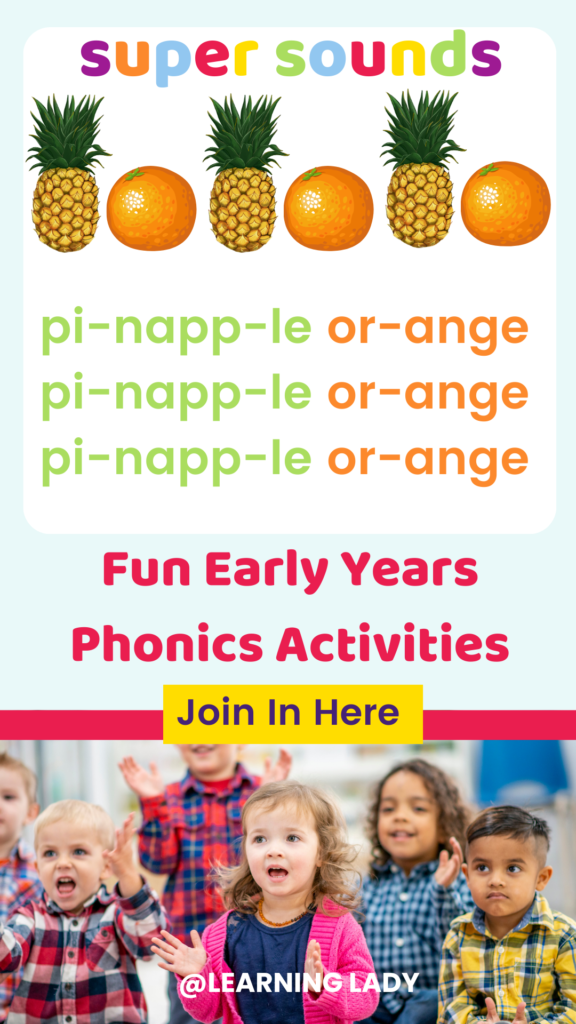
What you need
You don’t need anything to play this game but to start with, we found using the actual fruits, or photos of the fruits super helpful.,
How to play
This is a basic clapping game, where the children listen to a pattern clapped by an adult, then clap the pattern back like an echo.
- Before beginning, it’s a great idea to think of the patterns you want to use.
- We used the exotic fruits, but you could use any category you like, for example, different animals, types of transport etc.
- Once you’ve picked a category, make a list of words in the category.
- Work out the number of syllables or ‘beats’ in each word. The syllables in the words will form the ‘claps’.
For example, in the case of fruit you could use a list like this:
Man-go, passion-fruit, man-go, passion-fruit, man-go, passion-fruit,
Tan-ger-ine, man-go, tan-ger-ine, man-go, tan-ger-ine, man-go, tan-ger-ine, man-go
Pine-app-le, pine-app-le, tan-ger-ine, man-go, pine-app-le, pine-app-le, tan-ger-ine, man-go,.
Begin with simple two-part patterns, becoming more complex as listening and memory skills develop.
Fun Early Years Phonics Activities 2
Which Animal Is Hiding?
Brown Bear, Brown Bear, What Do You See? is a classic rhythmic book, and a great starting point for this super speedy game. Use the animals from the story or any toy animals you have to clap the syllables in the names of the animals. We tried to make sure we used 1, 2 and 3 syllable words for plenty of listening practise, here are a few:
Sloth (1 syllable)
Pa-rrot (2 syllables)
E-le-phant (3 syllables)
Fun Early Years Phonics Activities 3
We Are In A Jam!
The Bus Is For Us by Michael Rosen is a brilliant book for introducing this game. It has all the brilliant qualities of We’re Going On A Bear Hunt, with patterned and predictable language that makes it super easy for preschoolers to learn.
This was a lightbulb book for Patience, when she started showing signs of becoming a reader.
Because she quickly learnt the story from memory (it tuned into her sense of rhythm really well), we regularly observed her ‘telling’ the story to her friends.
A sure fire sign that she was becoming a reader!
What you need
A range of toy vehicles, the names of these need to contain a varied number of syllables or ‘beats’
For example,
Car (1 syllable or clap)
Lo-rry (2 syllables or claps)
Bi-cy-cle (3 syllables or claps)
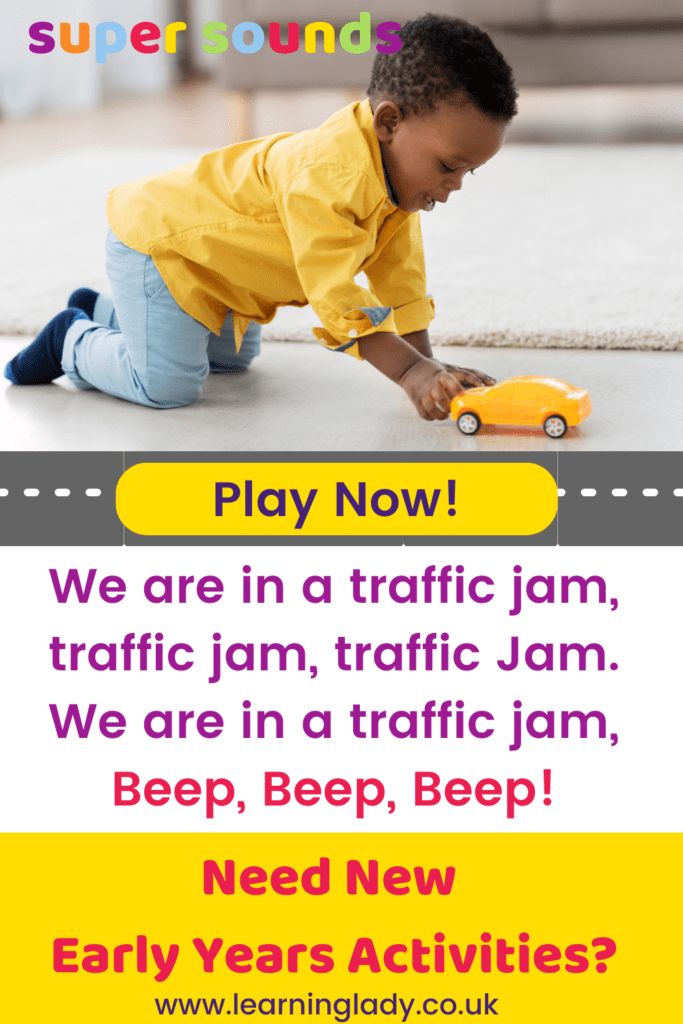
How to play
- Talk to the children about their experiences of being stuck in traffic.
- Explain that the children are going to be playing a traffic jam game with the toy vehicles.
Begin by chanting.
“We are in a traffic jam, raffic jam, traffic jam,
“We are in a traffic jam, Beep, beep beep.”
- Practise chanting this all together until the children begin to join in.
- Show the children the first vehicle from the collection. Can they clap the beats or syllables to match the object?
For example, “tra-ctor” (2 claps)
- Say the sentence “I can see a trac-tor” all together, clapping the syllables or ‘beats’ in the vehicle name as it is spoken.
- Place this on the floor in front of the children. This is the start of the traffic jam.
Then repeat the original chant all together.
“We are in a traffic jam,traffic jam, traffic jam,
We are in a traffic jam. beep, beep beep.”
- Introduce a second vehicle. Name then clap the number of beats or syllables to match the object all together.
For example, am-bu-lance (3 claps)
- Place the second vehicle behind the first to add to the traffic jam, then repeat the sentence all together.
“I can see a tra-ctor (2 claps) and an am-bu-lance (3 claps)”
- Support the children by pointing to each object in the traffic jam as it is recalled.
- Continue following this pattern of chanting, clapping, adding to the traffic jam, then recalling, until all the vehicles have been included in the traffic jam.
Fun Early Years Phonics Activities 4
The Train Ride
Like most preschool children, Patience loved to play outside, so we decided that one of our rhythmic books needed to relate to the provision in our playground.
The Train Ride by June Crebbin is a brilliant book for teaching rhythm because the careful use of patterned language replicates the rhythm made by a train.
The children helped us build a train with some chairs and a few old tyres and loved ‘playing trains’ once we’d introduced this classic rhythmic book.
Fun Early Years Phonics Activities 5
Syllable Scramble
Like Kitchen Disco, Bathroom Boogie by Clare Foges is a super fun and rhythmic book that quickly captures the imagination of 3 and 4-year-olds.
We used Bathroom Boogie as a fun starting point for this active early years phonics activity with great results. The children continued playing independently once the adults took a step back, with Patience taking a leading role.

What you need
A large space to play- this is an active game.
2 every day or common objects, each with a different number of syllables.
Place each object at either end of the large space.
How to play
- Begin with everyone in the centre of the large space.
- Show the children each of the objects in turn. Can they name each object?
- Practise clapping the beats or syllables in each word all together. Remember, the syllables are the ‘beats’ in words, each syllable or beat is created by a vowel.
- Place each object at opposite ends of the large space. Explain that the children are going to listen out for clapping clues, then run to the object with the matching number of ‘beats’ or syllables.
- Demonstrate by clapping the number of syllables in an object, then running to the corresponding object
- Show the children how to return to the center of the space, ready to play again with the next clapping clue.
- Encourage the children to listen carefully to the clapping clues, guiding by making choices between 1 and 3 syllables in the beginning.
For example: “Could it be the cup? (1 clap), or the toilet roll? (3 claps).”
- Play the game several times, speeding up the clapping and running for a real syllable scramble.
- Make the game more challenging as the children develop in skill and confidence. Increase the number of objects, including similar numbers of syllables (2 and 3 or 3 and 4) to encourage more complex differentiation between beats in words.
Was Patience ready for reading?
And did all of this hard work pay off for Patience? The short answer is:
“Yes!”
We had been intentional and focussed on the prephonics skill we wanted Patience to learn, and picked some books that made this possible.
Patience remembered many of these stories by memory because she had a good sense of rhythm, and that made her feel like a reader.
Because we’d taken the books to where she liked to play, she showed an interest in books much, much more. And, because she felt like a reader, she did more of it!
By the end of this preschool chapter, Patience was one step further on her journey to becoming a perfectly prepared preschooler.
